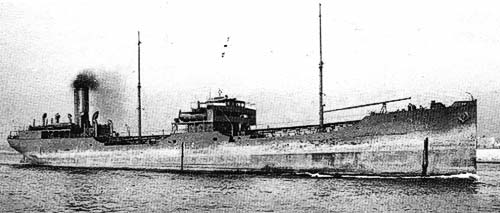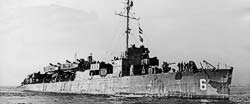
W.E. Hutton — 453-0" x 56-0" x 27-3" — Sunk: 3/18/1942
Papoose — 412-0" x 53-4" x 25-8" — Sunk: 3/19/1942
Ario — 453-0" x 56-2" x 27-1" — Sunk 3/15/1942
San Delfino — 463-0" x 61-0" x 33-0" — Sunk: 4/9/1942
Mirlo — 425-0" x 57-0" x 33-0" — Sunk: 8/16/1918
Only the recovery of a definitive, identifying artifact and further investigation will prove how much of this hypothesis holds up, but it seems pretty solid that the Papoose is really the W.E. Hutton and the description of the diving and wreck site photos below are from the W.E.Hutton wreck site. The ship history and historic photos contained on this page are for the Papoose.
The night of March 18, 1942 was not the first time that the tanker Papoose was involved in death and destruction. Sixteen years earlier, as a Dutch tanker, under the name Silvanus, she was traveling the Mississippi River when she rammed the tanker Thomas H. Wheeler. The collision and resulting fire killed 26 men. The Silvanus was declared a total loss and the hull was auctioned off to the highest bidder. She was purchased by the Petroleum Navigation Corporation and towed to Beaumont, TX where she was completely rebuilt and overhauled. On 3/31/1927, she was re-launched as the Papoose and spent the next 15 years carrying petroleum products from Texas to the east coast of the United States.

On the night of March 18, 1942, the Papoose was traveling southward, alone and unarmed, as she rounded Cape Lookout. Captain Roger Zalnick was following the recommendations from US Naval Routing Center and traveling as close to shore as possible. He wasn't on a zig-zag course as he wanted to pass thru "torpedo junction" as quickly as possible, but he was traveling blacked-out. The Papoose was enroute from Providence, RI to Port Arthur, TX, traveling "in ballast" (empty), to pick up a load of fuel oil.
The first torpedo struck at 2135 on the port side of the ship at stern end below the poop deck. The explosion pentrated the fuel tanks and ruptured the engine room bulkheads. Two crew members were killed in the explosion. Engines stopped and water rose to the cylinder heads in aproximately 4 minutes. The Papoose slowly glided to a stop as the Captain ordered lifeboats lowered. The crew were #1 and #3 lifeboats for only a few minutes when the phosphorescent stream of a second torpoedo passed near the lifeboats and hit the drifting tanker on the starboard side aft of the miships. It tore open a large hole at the water line and the tanker started to settle down at the stern, rolling to the starboard side.
The captain ordered the lifeboats to start rowing towards land and the burning torch of the tanker W.E. Hutton, also a victim of the U-124, sinking on the horizon. At 0730 on the 19th, the survivors of the Papoose were picked up by the destroyer USS Stringham (DD-83/APD-6) and taken to Norfolk, VA.










